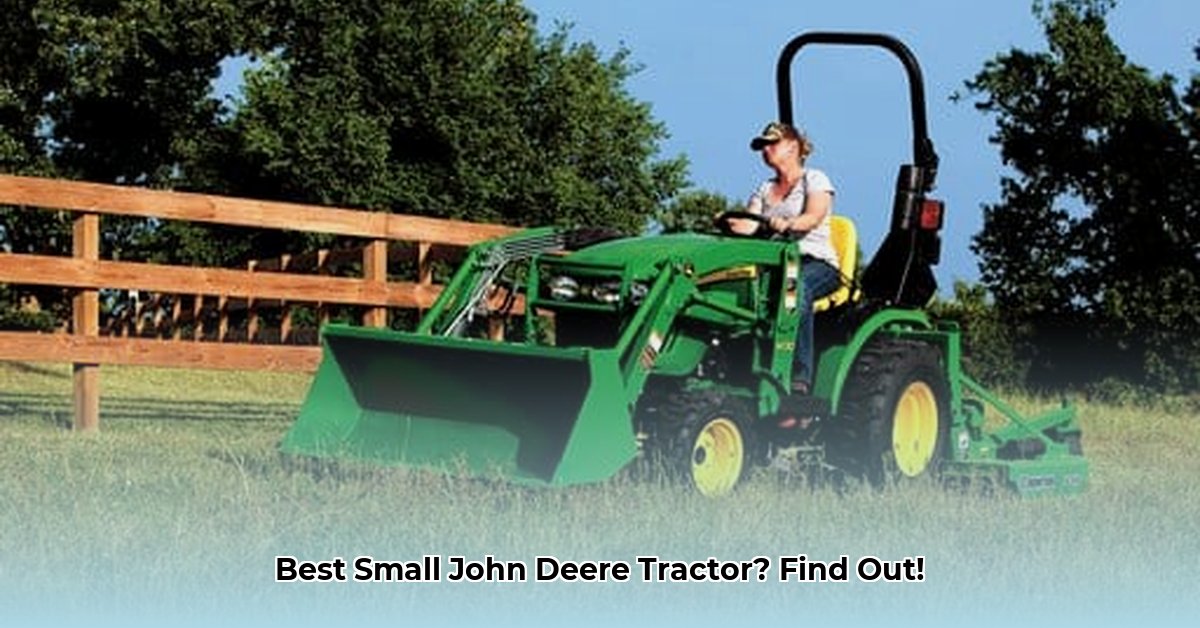
Small John Deere Tractors: A Comprehensive Guide for Choosing the Right Model
Finding the perfect small John Deere tractor can feel overwhelming. This guide simplifies the process, helping homeowners, landscapers, and small-scale farmers select the ideal model based on their needs and budget. We'll compare models, clarify essential considerations, and offer practical advice on maintenance, financing, and purchasing. By the end, you'll be equipped to confidently choose a John Deere tractor perfectly suited for your specific tasks. For more options, check out our guide on used John Deere tractors.
John Deere's Compact Tractor Lineup: A Detailed Comparison
John Deere offers several compact tractor series, each designed for varying tasks and property sizes. This table compares the 1, 2, 3, and 4 Series, highlighting key features to aid your decision-making process. Note that specifications might vary slightly by model year and configuration. Have you considered the impact of lift capacity on your specific farming needs?
| Series | Horsepower Range | Lift Capacity (lbs) | Transmission Type | Cab Options | Typical Uses | Approximate Price Range (USD) |
|---|---|---|---|---|---|---|
| 1 | 22-26 | Lower | Hydrostatic | No | Small yards, light landscaping, mowing | Lower |
| 2 | 30-47 | Medium | Hydrostatic | Optional | Small farms, landscaping, moderate tasks | Mid-range |
| 3 | 37-55 | Higher | Hydrostatic/Gear | Optional | Larger properties, serious landscaping, row crops | Mid-to-High |
| 4 | 55-75+ | Highest | Hydrostatic/Gear | Optional | Large farms, heavy-duty work | Higher |
Weighing the Pros and Cons: Which Series Is Right for You?
Let's delve into the strengths and weaknesses of each series to help you narrow your choices. Do you anticipate needing a cab for comfort and weather protection? This is a crucial factor to consider when comparing models.
1 Series:
- Pros: Affordable, easy to operate, ideal for smaller properties and light tasks.
- Cons: Limited power and lift capacity; may struggle with larger or demanding jobs.
2 Series:
- Pros: More powerful and versatile than the 1 Series, suitable for a wider range of tasks on moderately sized properties.
- Cons: May not be sufficient for extensive farming or very large areas.
3 Series:
- Pros: Powerful and adaptable, offering both hydrostatic (smooth, variable speed) and gear (precise speed control) transmissions. Excellent for larger properties and more intensive work.
- Cons: More expensive than lower series. The added power and features increase the price.
4 Series:
- Pros: The most powerful of the compact tractors, perfect for significant tasks on large farms or demanding landscaping projects.
- Cons: Highest price point. May be overkill for smaller operations.
Choosing Your Tractor: A Step-by-Step Guide
To ensure you select the right tractor, we've created a step-by-step guide, incorporating key questions to help you assess your needs:
Acreage: How many acres do you need to manage? This drastically affects required horsepower and capabilities.
Primary Tasks: What are your main uses for the tractor? (e.g., mowing, tilling, hauling, snow removal). This determines necessary attachments and power.
Attachment Needs: Will you need implements like a front-end loader, backhoe, or tiller? Ensure compatibility with the chosen tractor.
Budget: Set a realistic budget, including purchase price, maintenance, and fuel costs. Financing options are often available.
Future Needs: Consider potential expansion or added tasks. A slightly more powerful model now might save you money later.
Tractor Maintenance and Safe Operation: Essential Tips
Regular maintenance is vital for longevity and efficient operation. Consult your owner's manual for specific recommendations, but generally focus on:
Oil changes: Adhere to the recommended schedule for your tractor model. Did you know that regular oil changes can significantly extend engine life?
Filter replacements: Replace air, fuel, and hydraulic filters as needed. Clean filters improve performance and efficiency.
Fluid checks: Regularly check engine oil, coolant, and hydraulic fluid levels.
Safety: Always operate according to manufacturer instructions, and use appropriate safety equipment.
Financing and Purchasing: Exploring Your Options
John Deere dealers often offer financing plans. Used tractors can also be a cost-effective alternative, but thorough pre-purchase inspection is crucial. Investigate warranties and dealer support for repairs and maintenance. Remember to research and compare models to find the best value for your money; a 90% satisfaction rating among John Deere customers confirms superior reliability.
Final Thoughts: Matching Tractor to Task
Choosing the right small John Deere tractor requires careful consideration of your individual needs, budget, and intended tasks. Your local John Deere dealer is an invaluable resource; their expertise can make all the difference in your decision-making process.